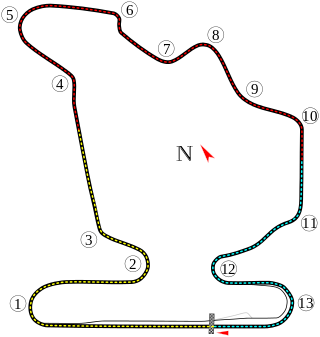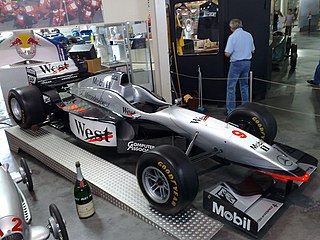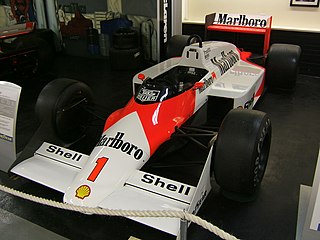Design
This was the first McLaren to use a semi-automatic transmission; it was a McLaren-designed electro-hydraulic clutch and paddle-shift unit with semi-automatic activation (a semi-automatic transmission had been tested during the previous season with the MP4/6 and was on track during practice for the 1991 Hungarian Grand Prix, but the team elected to retain that car's original manual transaxle for the entirety of that car's use in competition). The team's technology partner Techniques d'Avant Garde (TAG) helped with development. This system allowed the driver to keep his foot on the pedal, without lifting from it since the throttle cable was replaced with an electronic sensor. It also controlled engine speed, rev-matching, and clutch actuation automatically during gear changes. [2] The MP4/7A also gained traction control at the Hungarian Grand Prix. [3]
A variant of the car, dubbed MP4/7B, featuring an experimental active suspension system, was introduced in testing for that year's Portuguese Grand Prix, though it proved insufficiently reliable and was not used for the remainder of the 1992 season. The system would, however, be used on the MP4/7A's replacement, 1993's MP4/8.
With Honda pulling out of Formula One at the end of the 1992 season (after 69 wins as an engine supplier since 1983, 44 of them with McLaren), the team would be forced to use customer Ford V8 engines in 1993, thus the MP4/7A was the last McLaren to use the Japanese engines until the McLaren Honda partnership was renewed prior to the 2015 season; the failure of that partnership to produce a race-winning car means the MP4/7A remains the last Honda-powered McLaren Formula One car to win a Grand Prix.

Alain Marie Pascal Prost is a French retired racing driver and Formula One team owner. A four-time Formula One World Drivers' Champion, from 1987 until 2001 he held the record for most Grand Prix victories until Michael Schumacher surpassed Prost's total of 51 victories at the 2001 Belgian Grand Prix.

Ayrton Senna da Silva was a Brazilian racing driver who won the Formula One World Drivers' Championship in 1988, 1990, and 1991. One of three Formula One drivers from Brazil to become World Champion, Senna won 41 Grands Prix and set 65 pole positions, with the latter being the record until 2006. He died as a result of an accident while leading the 1994 San Marino Grand Prix, driving for the Williams team.

Gerhard Berger is an Austrian former Formula One racing driver. He competed in Formula One for 14 seasons, twice finishing 3rd overall in the championship, both times driving for Ferrari. He won ten Grands Prix, achieved 48 podiums, 12 poles and 21 fastest laps.

The 1989 Italian Grand Prix was a Formula One motor race held at Monza on 10 September 1989. It was the twelfth race of the 1989 Formula One season.

The 1990 German Grand Prix was a Formula One motor race held at the Hockenheimring on 29 July 1990. It was the ninth race of the 1990 Formula One World Championship. The race was the 52nd German Grand Prix and the 14th to be held at the Hockenheimring. It was the 39th and last Formula One Grand Prix to be held in West Germany prior to its re-unification with East Germany. The race was held over 45 laps of the seven kilometre circuit for a race distance of 306 kilometres.

The 1991 Hungarian Grand Prix was a Formula One motor race held at Hungaroring on 11 August 1991. It was the tenth race of the 1991 Formula One World Championship. The 77-lap race was won from pole position by Ayrton Senna, driving a McLaren-Honda, with the Williams-Renaults of Nigel Mansell and Riccardo Patrese second and third respectively.

The 1992 Brazilian Grand Prix was a Formula One motor race held at Interlagos on 5 April 1992. It was the third race of the 1992 Formula One World Championship.
The 1992 Canadian Grand Prix was a Formula One motor race held at Circuit Gilles Villeneuve, Montreal on 14 June 1992. It was the seventh race of the 1992 Formula One World Championship.

The 1992 Portuguese Grand Prix was a Formula One motor race held at Autódromo do Estoril on 27 September 1992. It was the fourteenth race of the 1992 Formula One World Championship.

The 1992 Australian Grand Prix was a Formula One motor race held at Adelaide on 8 November 1992. It was the sixteenth and final race of the 1992 Formula One World Championship.

The McLaren MP4/4, also known as the McLaren-Honda MP4/4, is one of the most successful Formula One car designs of all time. Powered by Honda's RA168E 1.5-litre V6-turbo engine and driven by teammates Alain Prost and Ayrton Senna, the car competed during the 1988 Formula One season. The design of the car was led by American engineer Steve Nichols, the full responsibility for the design of the chassis having been conferred on him by Ron Dennis. Gordon Murray, as Technical Director, had the role of liaising between the drawing office and production.

The Williams FW14 is a Formula One car designed by Adrian Newey, used by the Williams team during the 1991 and 1992 Formula One seasons. The car was driven by Nigel Mansell and Riccardo Patrese.

The McLaren MP4/6 is a successful Formula One racing car designed by McLaren's Neil Oatley, Matthew Jeffreys, David North, David Neilson, Bob Bell and Mike Gascoyne; powered by the Honda RA121E V12 engine for use in the 1991 Formula One season, with the engine's design and development led by Osamu Goto. It was driven by reigning World Champion, Brazilian Ayrton Senna, and Austria's Gerhard Berger. Ayrton Senna would win his third World Championship in the MP4/6. The MP4/6 was notable for being the last F1 car to win the championship with a manual gearbox and the only F1 car powered by a V12 engine to do so.

The McLaren MP4/5, and its derived sister model, the McLaren MP4/5B, were highly successful Formula One racing cars designed by the McLaren Formula One team based in Woking, England, and powered by Honda's naturally-aspirated RA109E and RA100E V10 engines respectively. The chassis design was led by Neil Oatley, teaming up with Steve Nichols, Pete Weismann, Tim Wright, Bob Bell and Mike Gascoyne. As with the previous designs, Gordon Murray, as Technical Director, had the role of liaising between the drawing office and production. Osamu Goto was the Honda F1 team chief designer for the car's engine.

The McLaren MP4/8 was the Formula One car with which the McLaren team competed in the 1993 Formula One World Championship. The car was designed by Neil Oatley around advanced electronics technology including a semi-automatic transmission, active suspension, two-way telemetry, and traction control systems, that were developed in conjunction with McLaren shareholder Techniques d'Avant Garde (TAG). It was powered by the 3.5-litre Ford HBD7 V8 engine and was the first McLaren to feature barge boards. The McLaren MP4/8 was also first Ford-powered McLaren car since McLaren MP4/1C in 1983.

The McLaren MP4/12 was the Formula One car with which the McLaren team competed in the 1997 Formula One World Championship. The chassis was designed by Steve Nichols, Neil Oatley and Henri Durand with Mario Illien designing the bespoke Ilmor engine. It was driven by Mika Häkkinen and David Coulthard.

The McLaren MP4/3 was the car with which the McLaren team competed in the 1987 Formula One World Championship. The car was designed under the leadership of long-time McLaren engineer Steve Nichols, in collaboration with Neil Oatley, Gordon Kimball, Tim Wright and Bob Bell. It was also the last McLaren car to be powered by the TAG-Porsche turbo engine that had been introduced in 1983. The car was driven by double World Champion Alain Prost, in his fourth season with the team, and Stefan Johansson, who moved from Ferrari.

The Ferrari 641 was the Formula One racing car with which the Ferrari team competed in the 1990 Formula One World Championship. Driven by Alain Prost and Nigel Mansell, it won six Grands Prix.

The McLaren MP4-29 was a Formula One racing car designed and built by McLaren to compete in the 2014 Formula One season. The chassis was designed by Tim Goss, Neil Oatley, Matt Morris, Mark Ingham and Marcin Budkowski and was powered by a customer Mercedes-Benz powertrain. The car was unveiled on 24 January 2014, and was driven by 2009 World Drivers' Champion Jenson Button and debutant Kevin Magnussen, who replaced Sergio Pérez, after he won the 2013 Formula Renault 3.5 Series title.

The Honda RA16 engine is a highly-successful and extremely powerful, turbocharged, 1.5-litre, 80-degree, V-6 racing engine, designed for use in Formula One; between 1983 and 1988. The customer engines were used by Spirit, Williams, Lotus, and McLaren.
























